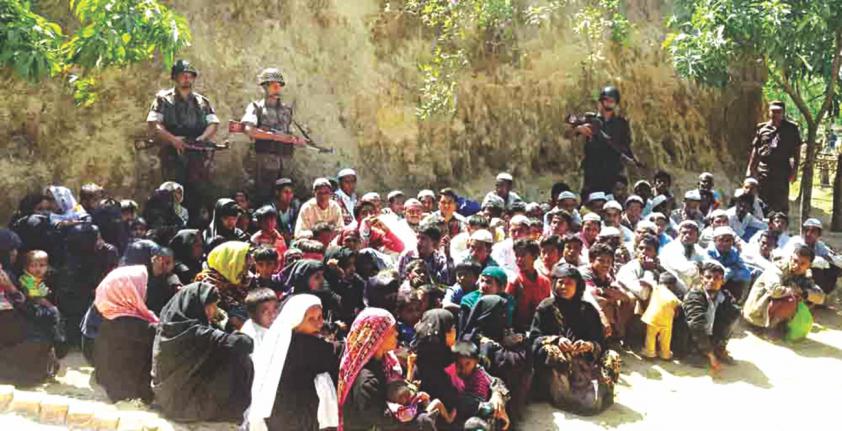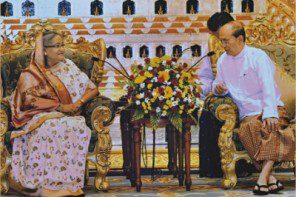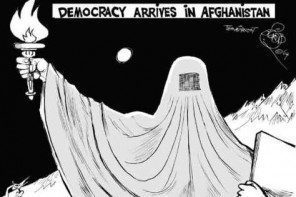Myanmar has been diversifying its foreign orientation in the context of rapidly-changing regional geopolitical dynamics since the military dominated Union Solidarity and Development Party (USDP) assumed power in November 2010. It has recently seen significant political developments which moved the country from the ‘policy of isolation’ towards a ‘policy of engagement.’ Political developments include the recently enacted bill in parliament allowing citizens to protest peacefully, initiatives to resume dialogues with other political parties, release of political prisoners and the hosting of parliament election on 9 July 2012. As a result, Myanmar, to some extent, has elevated its position in International Politics. Leaders of the Association of Southeast Asian Nations (ASEAN) agreed that Myanmar would chair the regional bloc in 2014. These changes have already given an indication that the country wants to realign its foreign policy breaking its long phase of isolation for decades. It also gives an assessment of which direction the country might take in the coming months and years.

Myanmar has witnessed a steady stream of visits by heads of State or government, foreign ministers of many countries of the world. Regional powers and the international community are very keen to realign their relations with Myanmar. In recent times, a ‘scramble for Myanmar’ might begin among the regional and international players to establish dominance over the oil and gas reserves of Myanmar. In light of these developments, this article will particularly focus on the state of bilateral relationship between Bangladesh and Myanmar. It will also identify the bottlenecks in developing a new era of relationship with Myanmar delineating an assessment of what Bangladesh could do to set the bilateral ties based on mutual trust and mutual benefit.
Many analysts in Bangladesh used to perceive the foreign policy of Myanmar in light of regional power settings. However, one should understand that the foreign policy of a country is shaped by their respective geopolitical, cultural, domestic and international compulsions. It may be mentioned that the military regime that assumed power in Myanmar in 1962, in the face of internecine fighting of the ethnic groups, restored the law and order in the entire country by using coercive means. It was also forced to build a strategic partnership with China to ward off strenuous international pressure of the western world. This country later moved forward to cement its ties with another regional power, India after the end of the Cold War. One can easily understand the trend of the foreign policy of Myanmar from the perspective of regime security.
Current State of Bangladesh Myanmar Relations
Bangladesh officially began diplomatic ties with Myanmar on January 13, 1972, the date on which Myanmar recognized Bangladesh as a sovereign state. However, over the last 40 years, the bilateral relations did not realize its full potential despite having a lot of opportunities for strengthening mutual cooperation on many areas. Both the countries have not undertaken any pragmatic approach till date.
One can easily understand this trend of bilateral relationship to look into the nature of transactions between the two countries. A local media report stated that Myanmar had exported over 8.5 million U.S. dollars’ worth of goods to Bangladesh through Maungtaw border point in the fiscal year 2011-12, up about 1.85 million USD from 6.65 million USD in 2010-11. Of the total, Myanmar’s import from Bangladesh reached 692,000 USD while Myanmar’s export to Bangladesh stood at 7.8 million USD. Myanmar exports to Bangladesh marine products, beans and pulses, and kitchen crops, while it imports from Bangladesh pharmaceuticals, ceramic, cotton fabric, raw jute, kitchenware and cosmetic. The main reason for the limited transactions was that businessmen of both the countries had been settling their payments for bulk shipments through bank drafts issued by foreign banks to a third country. In January 2012, the state owned Sonali Bank of Bangladesh and the two other private banks were given permission for opening of Letter of Credit (LCs) facility to Myanmar. The other reason for this minimum interaction was that both the countries have failed to identify the areas from where they could achieve comparative advantage.
Myanmar, closed to the outside world for more than 50 years, showed few distinct patterns of behaviour in developing effective bilateral relations with Bangladesh. These distinct patterns of behaviour included the capitalization of Bangladesh’s geographical vulnerability, the reluctance to enter into meaningful bilateral relationship the stubborn attitude and behavior to solve bilateral disputes and more inclination towards India and China to harness benefits. Due to these reasons Bangladesh was discouraged to develop effective bilateral relations with Myanmar.
Although Bangladesh is aware about the potential of its Look-East Policy, it has, to date, failed to achieve anything by pursuing this policy with Myanmar. Despite having a close geographic proximity with Myanmar, there are no air links, no direct road connectivity, and no shipping links between the two countries. Therefore, it is high time to strengthen the economic and political interactions with that country. Bangladesh should understand Myanmar in the context of recent changes which have taken place there and the needs of the common people in that country. Bangladesh must find common issues to foster bilateral relations because cooperation with Myanmar has reached a paramount importance if Bangladesh wants to gain benefit through perusing its Look East Policy.
The Stateless Rohingyas
The Rohingya issue mostly affected the bilateral relationship since they have started entering into Bangladesh from 1978. Though Bangladesh officially accommodates 29,000 Rohingya refugees, different estimates suggest the number of the Myanmarese minorities living in and around Cox’s Bazar ranges between 2.5 and 5 lakh. It is a major concern for Bangladesh that Myanmar is reluctant to accept these persons as their citizens. They are now involved in drug trafficking, land grabbing, deforestation and commit other criminal offenses to lead their lives.

During the 70’s decade, Pakistan based militant organizations particularly Harkatul Jihad, getting financial help from the Middle Eastern countries, recruited some Rohingya refugees to fight against Soviet Union in Afganistan. These militants returned after the end of the Cold War organized three insurgent outfits named the Rohingya Solidarity Organization (RSO), Arakan Rohingya National Organization (ARNO) and Arakan Liberation Front (ALF) to launch insurgent operations inside the Rakhaine state of Myanmar. As they were operating from near the Bangladesh Myanmar border areas, Myanmar alleged that within Bangladesh, forces sympathetic to the causes of Rohingya did not oppose the militancy of the latter. They, on the contrary, came forward with arms and materials to help the Rohingyas fight against the security forces of both Myanmar and Bangladesh. However, the Rohingya issue starts affecting the security of both the countries which has become the main barrier in promoting bilateral relations with Myanmar. Policy makers in Myanmar have fear that this insurgency problem might escalate if any direct road link is to be established between the two countries. Bangladesh should undertake a policy of constructive engagement to erase this wrong apprehension from the mind of the policy makers in Myanmar.
Drug Trafficking
Drug trafficking and drug abuse have emerged as one of the most serious organized crimes in Cox’s Bazaar, causing incalculable costs on individuals, families, communities, and governments. Drug traffickers are also draining huge amount of money from Bangladesh to Myanmar through Hundi. Media reports revealed that Myanmar’s businessmen have set up many factories in the Shan Province, near Thailand border, to produce YABA targeting the domestic market of Bangladesh. Bangladesh has already given a list of businessmen to Myanmar about who is involved in the smuggling of narcotics in the Bangladesh Myanmar border. If intelligence reports are to be believed the Nasaka is directly or indirectly involved in this profitable business and for this reason drug traffickers are easily crossing the border. Despite repeated appeals from Bangladesh, they did not take any action to dismantle these factories.
The Matrix of Geopolitics in Bangladesh Myanmar Relations
The main strategic objective of Bangladesh is to connect itself with China and other South East Asian countries using the territory of Myanmar. Bangladesh is also interested to boost up its trade with the North Eastern States of India. The geopolitical importance of Bangladesh will remain intact to India, China and other South Asian countries if it can become a bridge between South Asia and the South East Asian Countries.
The recent visit of the Indian Prime Minister Dr. Monmohan Singh to Myanmar might have slightly uplifted the geopolitical importance of that country. Myanmar has already undertaken three major port projects on the coast; one each in collaboration with India, China and Thailand. The first project is the Kaladan Multi-Modal Transit Transport Project (KMMTT) which will be implemented by India revitalizing the abandoned Akyab port, presently known as Sittwe port, in the Rakhine state. The main objective of India is to connect Mizoam, via the Kaladan River with this port. Further down the coast, also in Rakhine state, is the Kyaukphyu project of China. To the south east of the country in the Tanintharyi Division, Myanmar is building the Dawei port where Thailand as the lead nation for implementation. Under recent agreements with Dr. Monmohan Singh, India will be able to use this port in order to establish direct road connections with Thailand and other South East Asian countries.
India also envisages developing a Trilateral Highway project between India, Myanmar and Thailand, with a vision of inter-linking the Indian Ocean with the South China Sea. It is a component of the Asian Highway, which is to be completed by 2016. This Trilateral Highway project will be constructed in line with the Asian Highway one and two proposed by the United Nations Economic and Social Commission for Asia and Pacific (UNESCAP). It is important to note that the construction of the third route via Bangladesh to Myanmar will largely depend on the consent of Myanmar. Bangladesh, therefore, needs to undertake robust diplomacy to get cooperation from Myanmar in order to open this route with an aim to connecting itself with the Asian Highway.
Myanmar has emerged as the major competitor of Bangladesh in utilizing the advantage of geo strategic location as it is offering transit facilities to India, China and other south East Asian countries. Thus, with the coming of the Asian Highway, Myanmar will become the point of convergence as well as the linking route between India, China and the South-East Asia as ‘Myanmar has consistently opposed the southern route proposed by Bangladesh as part of Asian Highway for reasons of national security.’ As such, Myanmar has taken aggressive measures to foster economic development by promoting trade and foreign direct investment (FDI), power generation, oil exploration as well as strengthening rail, road, and air connectivity. These activities taken by Myanmar clearly indicate that this country wants to become the hub of business activities in the forthcoming years. ‘Myanmar’s fortunes, as reforms roll on, are likely to rest on how skillfully its leaders, whether military or civilian, can make use of their geography.’
Another significant feature is that Chinese and Indian companies are sometimes jointly working in various sectors of Myanmar. Meanwhile, Indian businesses have already started participating in major Chinese projects in Myanmar. Punj Lloyd, an Indian Company, is the major subcontractor in the project to build an oil pipeline from the Bay of Bengal to Southwestern China. India’s public companies, OVL and GAIL, have already ensured minority stakes in Myanmar’s offshore hydrocarbon development projects that will supply energy to China. The possibilities of rivalry between India and China on capturing the resources of Myanmar are decreasing at this moment. Realizing the geo-strategic and geo-economic importance of Myanmar, China and India have already ensured their presence in the development process of Myanmar where Bangladesh remains no where.
The way forward
Bangladesh Myanmar relations are now at crossroads. Bangladesh needs to inculcate a sense of trust into the mind of the present government of Myanmar that the longstanding unresolved issues between these two countries would no longer create hindrances in promoting economic prosperity. This economic prosperity will harness mutual benefit for the common people of both the countries. The policy makers in Bangladesh need to address some common areas where both the countries can strengthen their cooperation.
In view of the present situation, Bangladesh should take some concrete steps to boost up ties with Myanmar. These steps include diversification of the export items of Bangladesh targeting the domestic market of Myanmar, establishment of a smooth channel of financial transactions as well as building direct road and air links between the two countries and signing of an inland water transport protocol. To deepen connectivity between the two countries, Bangladesh can proceed with Myanmar in joint investment to build a hydroelectric project from where electricity could be supplied to Bangladesh. It can also set up a fertilizer plant under a joint investment where Myanmar might supply natural gas. Besides taking bilateral initiatives, Bangladesh should also be active to improve bilateral ties through certain regional and sub-regional forums, such as the Bay of Bengal Initiative for Multi-Sectoral Technical and Economic Cooperation (BIMST-EC), the ASEAN Regional Forum and the Bangladesh-China-India-Myanmar Forum (BCIM).
Conclusion
In her recent visit to Myanmar in December 2011, Prime Minister Sheikh Hasina signed an agreement on the establishment of a Joint Commission for bilateral cooperation between the Government of the Republic of the Union of Myanmar and the Government of the People’s Republic of Bangladesh and a Memorandum of Understanding on the establishment of a Joint Business Council (JBC) between the Republic of the Union of Myanmar Federation of Chambers of Commerce and Industry (UMFCCI) and the Federation of Bangladesh Chambers of Commerce and Industry (FBCCI). These steps are important but not enough in view of the present pace of transformation in the regional politics. The main strategic objective of Bangladesh is to connect itself with the Asian Highway through Myanmar. The success of this will strongly depend on solid bilateral relations based on multifaceted economic and political cooperation between the two countries.
However, the prospect of this relationship depends on how Bangladesh can seize the opportunities to expand its relations with the present government of Myanmar. Bangladesh should learn the lessons from China and India and must undertake a pragmatic approach to foster cooperative efforts and inter-connectivity which are considered as catalysts for economic growth and prosperity for the entire region.





